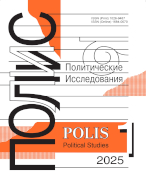Влияние стриминговых сервисов на киноиндустрию и стратегии мягкой силы Китая, Южной Кореи и Японии
Паксютов Г. Д.,
Институт Китая и современной Азии РАH, Москва, Россия, gpaksyutov@mail.ru
elibrary_id: 965340 | ORCID: 0000-0001-7153-4315 | RESEARCHER_ID: ABF-9928-2021
Дата поступления статьи: 2022.01.21. Принята к печати: 2022.08.19

DOI: 10.17976/jpps/2023.02.04
EDN: ITXUKL
Паксютов Г. Д. Влияние стриминговых сервисов на киноиндустрию и стратегии мягкой силы Китая, Южной Кореи и Японии. – Полис. Политические исследования. 2023. № 2. С. 41-53. https://doi.org/10.17976/jpps/2023.02.04. EDN: ITXUKL
Статья посвящена сравнительному анализу влияния стриминговых сервисов (Netflix и др.) на индустрию кино и сериалов в Китае, Японии, Южной Корее и, соответственно, на ресурсы и стратегии мягкой силы этих стран. Автор рассматривает особенности и факторы успеха стриминговых сервисов в сравнении с традиционной бизнес-моделью киноиндустрии. Исследование показало, что Китай очень ограниченно сотрудничает с американскими сервисами, не предоставляет им доступ на национальный рынок и не стремится продвигать продукцию национальной киноиндустрии посредством цифровых платформ – тенденция, которую автор объясняет стремлением сохранить культурный суверенитет. Южнокорейские профессионалы индустрии кино, напротив, активно сотрудничают с Netflix, что вписывается в общую стратегию по продвижению культурной продукции страны, основанную на использовании цифровых медиа и социальных сетей как канала дистрибуции. Эта тенденция поддерживается правительством Южной Кореи в рамках национальной стратегии мягкой силы. В Японии в последние годы также интенсифицируется сотрудничество производителей аудивиозуального контента (в первую очередь анимации) и американских стриминговых сервисов, чему способствуют ситуация на внутреннем рынке японских креативных индустрий, старение населения и необходимость в диверсификации доходов. Сотрудничество с глобальными цифровыми платформами, однако, сопряжено с рисками передачи управления национальными культурными индустриями под внешнее управление, размывания культурной идентичности страны. В заключении обсуждаются проблемы, которые рассмотренная тема ставит перед исследователями, подчеркивается необходимость учитывать стратегические задачи стран при оценке эффективности их стратегий мягкой силы.
Список литературы
Маклюэн М. 2019. Понимание медиа: внешние расширения человека. М.: Кучково поле.
Паксютов Г.Д. 2020. Бизнес-модель компании Netflix: экономическое и социокультурное значение. Вестник РЭУ им. Г.В. Плеханова. Т. 17. № 3. 145-156. http://dx.doi.org/10.21686/2413-2829-2020-3-145-156. EDN: VTAOQA.
Рескин Д. 2021. Лекции об искусстве. СПб.: Азбука-Аттикус.
Araujo, M. (2020). Além do animê: Reality TV e o soft power japonês [Beyond the anime: reality TV and the Japanese soft power]. Fronteiras – estudos midiáticos, 22(2), 103-113. (In Portuguese) https://doi.org/10.4013/fem.2020.222.09
Couldry, N., & Mejias, U.A. (2019). Data colonialism: rethinking big data’s relation to the contemporary subject. Television & New Media, 20(4), 336-349.
De Vany, A. (2004). Hollywood economics: how extreme uncertainty shapes the film industry. London: Routledge.
Hernandez, A.D.H. (2018). The anime industry, networks of participation, and environments for the management of content in Japan. Arts, 7(3), 42. http://dx.doi.org/10.3390/arts7030042
Holroyd, C. (2019). Digital content promotion in Japan and South Korea: Government strategies for an emerging economic sector. Asia & the Pacific Policy Studies, 6(3), 290-307. https://doi.org/10.1002/app5.277
Iwabuchi, K. (2004). How «Japanese» is Pokemon? In J. Tobin (Ed.), Pikachu’s Global Adventure: The Rise and Fall of Pokemon (pp. 53-79). Durham, London: Duke University Press.
Jiang, S. (2017). China’s Hong Kong: A political and cultural perspective. Singapore: Springer.
Jin, D.Y. (2017). Construction of digital Korea: the evolution of new communication technologies in the 21st century. Media, Culture & Society, 39(5), 715-726. https://doi.org/10.1177%2F0163443717709441
Jung, S. (2011). Korean masculinities and transcultural consumption: Yonsama, Rain, Oldboy, K-pop idols. Hong Kong: Hong Kong University Press.
Jung, H. (2017). Transnational media culture and soft power of the Korean Wave in the United States. In T.-J. Yoon, & D.Y. Jin (Ed.), The Korean Wave: Evolution, Fandom, and Transnationality. (pp. 225-244). Lanham: Lexington Books.
Keane, M., & Wu, H. (2021). Online platforms, cultural power, and China’s pan-Asian strategy. In D.Y. Jin (Ed.), The Routledge Handbook of Digital Media and Globalization (pp.158-166). New York, London: Routledge.
Keping, Y. (2009). Democracy is a good thing. Washington: Brookings University Press.
Kim, J.O. (2021). The Korean wave and the new global media economy. In D.Y. Jin (Ed.), The Routledge Handbook of Digital Media and Globalization (pp. 77-86). New York, London: Routledge.
Kim, Y. (2022). Introduction: popular culture and soft power in the social media age. In Y. Kim (Ed.), The Soft Power of the Korean Wave (pp. 1-38). Abindgon, New York: Routledge.
Lie, J. (2012). What is the K in K-pop? South Korean popular music, the culture industry, and national identity. Korea observer, 43(3), 339-363.
Lobato, R. (2019). Netflix nations. New York: New York University Press.
Lorenzen, M., & Mudambi, R. (2013). Clusters, connectivity and catch-up: Bollywood and Bangalore in the global economy. Journal of Economic Geography, 13(3), 501-534.
Masuda, H., et al. (2021). Anime industry report 2020: Summary. Tokyo: The Association of Japanese Animations.
Matthew, J.R. (2020). Netflix and the design of the audience: the homogeneous constraints of data-driven personalization. MedieKultur: Journal of Media & Communication Research, 36(69), 52-70.
Mihara, R. (2020). Involution: a perspective for understanding Japanese animation's domestic business in a global context. Japan Forum, 32(10), 102-125.
Murphy, P. (2010). The limits of soft power. In D. Black, S. Epstein, A. Tokita (Ed.), Complicated Currents: Media flows, soft power and East Asia (pp. 319-340). Melbourne: Monash University Press.
Nye, J.S. (1990). Soft Power. Foreign Policy, 80, 153-171.
Nye, J.S., & Kim, Y. (2013). Soft power and the Korean wave. In Kim Y. (Ed.), The Korean Wave: Korean Media Go Global (pp. 29-40). London, New York: Routledge.
Otmazgin, N.K. (2018). The Chrysanthemum and the cool: cultural diplomacy and soft power in Japan’s foreign policy. In M.M. McCarthy (Ed.), Routledge Handbook of Japanese Foreign Policy (pp. 55-70). Abingdon: Routledge.
Pajkovic, N. (2021). Algorithms and taste-making: Exposing the Netflix recommender system's operational logics. Convergence, 28(1), 214-235. https://doi.org/10.1177%2F13548565211014464
Paksiutov, G.D. (2021). Transformation of the global film industry: prospects for Asian countries. Russia in Global Affairs, 19(2), 111-132. https://doi.org/10.31278/1810-6374-2021-19-2-111-132
Parc, J., & Kawashima, N. (2018). Wrestling with or embracing digitalization in the music industry: the contrasting business strategies of J-pop and K-pop. Kritika Kultura, 30, 25-48.
Peng, W. (2015) China, film coproduction and soft power competition. Brisbane: Queensland University of Technology.
Peng, W., & Keane, M. (2019). China’s soft power conundrum, film coproduction, and visions of shared prosperity. International Journal of Cultural Policy, 25(7), 904-916. https://doi.org/10.1080/10286632.2019.1634062
Postman, N. (1993). Technopoly: the surrender of culture to technology. New York: Vintage Books.
Postman, N. (2006). Amusing ourselves to death. New York: Penguin Books.
Sun, W. (2017). Soft power by accident or by design: if you are the one and Chinese television. In P. Voci, & L. Hui (Ed.), Screening China's Soft Power (pp. 194-209). London: Routledge.
Thussu, D. (2020). India's soft power. Lumina. 14(1), 111-124. http://doi.org/10.34019/1981-4070.2020.v14.30137
Vlassis, A. (2021). Global online platforms, COVID-19, and culture: the global pandemic, an accelerator towards which direction? Media, Culture & Society, 43(5), 957-969. http://dx.doi.org/10.1177/0163443721994537
Wang, W.Y., & Lobato, R. (2019). Chinese video streaming services in the context of global platform studies. Chinese Journal of Communication, 12(3), 356-371. https://doi.org/10.1080/17544750.2019.1584119
Возможно, Вас заинтересуют:
Круглый стол журнала «ПОЛИС» , Стрельцов Д. В., Чугров С. В., Карелова Л. Б., Ознобищев С. К.,
Россия и Япония. Часть II. Взгляд из России. – Полис. Политические исследования. 2014. №1
Иногути Т. ,
Политическая наука в трех демократиях: “нелояльной” (Япония), демократии “третьей волны” (Южная Корея) и “зарождающейся” (Китай). – Полис. Политические исследования. 2004. №5
Лю Ц. ,
«Мягкая сила» в стратегии развития Китая. – Полис. Политические исследования. 2009. №4
Костырев А. Г.,
Разумная сила, общественная дипломатия и социальные сети как факторы международной политики . – Полис. Политические исследования. 2013. №2
Круглый стол журнала «ПОЛИС» , Медоева З. Г., Василенко И. А., Малышева Е. М., Хауер-Тюкаркина О. М., Чугров С. В.,
Образ России: дефицит «мягкой силы»?. – Полис. Политические исследования. 2013. №4





.jpg)






 версия для печати
версия для печати
.jpg)
.jpg)